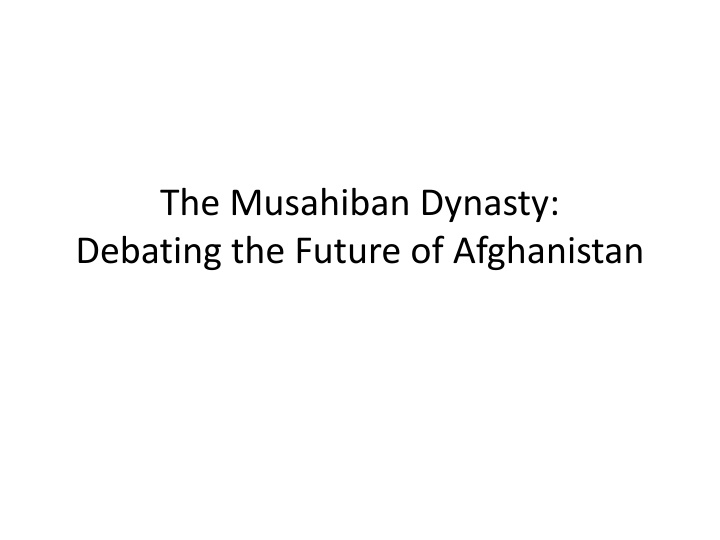
Exploring the Musahiban Dynasty and Afghanistan's Future through History
Delve into the historical journey of the Musahiban Dynasty in Afghanistan, reflecting on critical issues such as geopolitics, national identity, and cultural transformations. From the legacy of the Gandemak treaty to Amanullah's push for independence, witness the evolution of Afghanistan through key events like the Third Anglo-Afghan War and the subsequent quest for allies on a global stage. Discover how Kabul has shaped Afghan national identity, introduced constitutional reforms, and navigated cultural shifts towards modernization. Experience a visual narrative of Afghanistan's past, debating its future amidst debates over culture, religion, and centralization efforts led by Amanullah.
Download Presentation

Please find below an Image/Link to download the presentation.
The content on the website is provided AS IS for your information and personal use only. It may not be sold, licensed, or shared on other websites without obtaining consent from the author. If you encounter any issues during the download, it is possible that the publisher has removed the file from their server.
You are allowed to download the files provided on this website for personal or commercial use, subject to the condition that they are used lawfully. All files are the property of their respective owners.
The content on the website is provided AS IS for your information and personal use only. It may not be sold, licensed, or shared on other websites without obtaining consent from the author.
E N D
Presentation Transcript
The Musahiban Dynasty: Debating the Future of Afghanistan
From Abdur Rahman to the Musahiban Major issues 1) Geopolitics and foreign interests, the legacy of Gandemak 2) Developing national(ist) identity, Afghanistan is Kabul 3) Debates over culture and religion, the identity of Afghanistan and the Afghan state
Geopolitics: The Third Anglo-Afghan War May 6 Aug. 8, 1919 Amanullah pushes independence from British Afghanistan attacks through Khyber Pass Ends with RAF bombing Kabul Total British victory, except Peace treaty gives Afghanistan right to control foreign relations
Third Anglo-Afghan War, Aftermath Occasion of Afghan Independence Day Joins League of Nations Afghanistan attempts to find allies far removed from local geopolitics. 1927: Amanullah travels to Turkey, Iran, Western Europe Queen Soraya and Amanullah in Germany
Afghanistan is Kabul Pushes Afghan national identity, conceived in and enforced from Kabul 1923: First written constitution Civil Rights for all Afghans Elected legislature Make state interactions transparent and standardized Remove tribal elders from military recruitment process Ends state subsidies for tribal elders and junior members of the Muhammadzai clan 1928: National bank and currency, the afghani
Culture and Religion Attempt to put Afghanistan at the forefront of modernization and reform in the Muslim world. Western dress for men in Kabul New schools, coed w/ secular curriculum Veiling no longer required by law.
Culture and Religion Cultural changes become symbolic of Kabul centralization, especially reform of marriage laws Most reforms only effected in Kabul itself Still attracts opposition from traditional power bases
Habibullah Kalakani (r. Jan. Oct. 1929)
Musahiban Dynasty Muhammadzai Pashtuns retake power after nine months Muhammad Nadir Shah (1929-1933) Undoes all of Amanullah s reforms 1931: New constitution Parliament replaced by loya jirga Increases size and scope of army
Kabul and Afghanistan 1933: Nadir Shah assassinated by a college student Demonstrates the constituency for Amanullah s reforms Young Urban Educated Kabul-centric If you re going to be overthrown whether you reform or not, what s a shah to do?
Muhammad Zahir Shah (r. 1933-1973) Comes to power at age 19 Leaves his uncles holding real power Focus on modernization of infrastructure Modernization will lead to centralization and reform
Forging a National Identity Create a Kabul centered national identity which combines Pashtun and Tajik elements Radio Kabul/Afghanistan (the news from Kabul) National Museum National Afghan Music (mixing Tajik/Persian poetry with Pashtun rhythms and melodies) National Buzkashi
Still rather Pashtu Centered Pashtu control of government power (but not bureaucracy) 1937: Pashtu Academy founded to create new Pashtu words 1938: Pashtu becomes official language of Afghanistan Limits of government power: Dari still dominates in Kabul and the north 1960 s: Dari allowed for government business 1964: Recognizes Dari and Pashtu as state languages






















